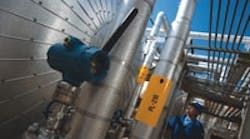Each of the 550 employees that clock into work at Posco's steel plant in Pohang Ironworks in Seoul, South Korea, wears a specially designed helmet fitted with an electronic tag. The tag sends signals picked up by 80 different sensors spread throughout the massive plant, providing specific data information on which areas of the facility workers are concentrated, what machinery they are working on and how much time is spent in each place.
Posco, the second-largest steel manufacturer in the world, believes that data provides invaluable information, especially in the area of health and safety.
That a sensor can track the movement of an object -- be it a product or person -- is no breakthrough. What is, however, is the intelligence, flexibility, and reduced complexity of the sensor technology, which has allowed manufacturing facilities to link physical objects, such as equipment, products or people, to wireless networks and process data in real-time. Sensors are not only gauging measurements, but can now sense vibrations for predictive maintenance and anticipate part failures.
"We call it the arrival of the digital plant," says Terry Krouth, chief technology officer at Emerson Process Management. "Facilities are transforming from analog to wireless. They are telling you measurements but also the health of the process equipment, the compressor and the motor. It's about the health of the whole plant."
According to Paul Chang, who oversees IBM's worldwide business strategies and emerging technologies division, advances in sensors used in a factory and plant have reflected the evolution of cell phones: Devices have grown smarter through embedded software, allowing each one to become an intelligent node on a communication network. All of which has allowed manufacturers to gain greater visibility into their processes.
A smart wireless transmitter installation monitors suction and discharge pressures, levels, flow and temperatures at BP's refinery tank farm in Naperville, Ill.
Hacros Chemicals, a distributor and producer of various industrial chemicals, has used advanced sensors to determine whether valves on reactors and exchangers are open or shut. Previously, that had been a time-consuming task that required multiple operators to check, then double-check, before a new process could begin.
"We've used sensors to minimize employee exposure to some of these chemicals," says Lloyd Hale, director of manufacturing at Hacros. "We're also using wireless sensors because they're invaluable, especially in an explosive environment where everything has to be explosion-proof."
In recent years, a key breakthrough for wireless sensors was the advent of WirelessHART, a wireless mesh network communications protocol for process automation applications. In such networks, sensors transmit with only enough power to communicate with their neighbors. The more neighbors they have, the stronger the network.
New software breakthroughs are making it possible to make that network even more intelligent. Hewlett-Packard recently announced its launch of CeNSE (short for Central Nervous System for the Earth), which proposes sticking billions of sensors on everything in sight and concentrating the resulting flood of data into insights into energy efficiency.
HP's first customer is Shell Oil Co. Sensors will be laid on the ground at regular intervals across hundreds of square miles, listening for sound waves to identify pockets of oil. The seismic data would then be uploaded to servers and processed by software to map specific locations.
Small thin-layer sensors, such as this one from Endress+Hauser, have grown smaller in size, yet are faster and more tolerant of vibration.
For example, he says nano-sensors could be embedded in the grease inside an electric motor, sensing the properties in the grease, such as metal particles, and indicate if there may be potential for breakdown in the insulation.
"Sensing technology is emerging at an incredible rate," says Chand. "And nanotechnology is going to unleash a new generation of smart devices."
See Also





